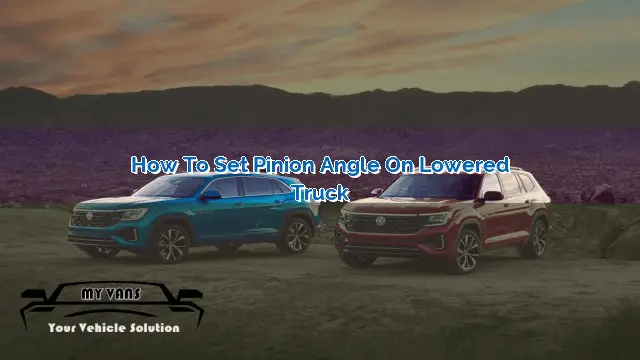
If you own a lowered truck, you know how important it is to have a proper pinion angle. A pinion angle is the angle between the driveshaft and the differential pinion. A proper pinion angle ensures that your truck’s driveshaft operates smoothly and efficiently. In this article, we will guide you on how to set the pinion angle on your lowered truck.
Step 1: Measure the Existing Pinion Angle
The first step is to measure the existing pinion angle of your truck. You can do this by using an angle finder or a digital protractor. Place the angle finder on the driveshaft and read the angle. Then place the angle finder on the differential pinion and read the angle. The difference between these two angles is your pinion angle.
Step 2: Determine the Ideal Pinion Angle
The ideal pinion angle for a lowered truck is between 2 to 4 degrees. This angle ensures that the driveshaft operates smoothly without any vibrations. However, the ideal pinion angle may vary depending on the type of truck and suspension setup. Check your truck’s manual or consult with a professional mechanic to determine the ideal pinion angle for your specific make and model.
Step 3: Adjust the Pinion Angle
Now that you have measured the existing pinion angle and determined the ideal pinion angle, it’s time to adjust the pinion angle. There are several ways to do this:
Option 1: Shims
You can use shims to adjust the pinion angle. Shims are placed between the leaf spring and the axle housing. Adding shims will tilt the axle housing and change the pinion angle. Use a torque wrench to tighten the U-bolts to the recommended torque specification.
Option 2: Adjustable Control Arms
If your truck has adjustable control arms, you can use them to adjust the pinion angle. Adjust the control arms until you achieve the desired pinion angle. Use a torque wrench to tighten the control arm bolts to the recommended torque specification.
Option 3: Traction Bars
Traction bars can also be used to adjust the pinion angle. Traction bars are attached to the axle housing and the frame of the truck. Adjust the traction bars until you achieve the desired pinion angle.
Option 4: Driveshaft Spacers
If none of the above options work, you can use driveshaft spacers to adjust the pinion angle. Driveshaft spacers are placed between the driveshaft and the differential pinion. Adding or removing spacers will change the pinion angle.
Step 4: Test Drive
After adjusting the pinion angle, take your truck for a test drive. Listen for any unusual noises or vibrations. If everything feels smooth and there are no vibrations, then you have successfully set the pinion angle on your lowered truck.
Setting the pinion angle on a lowered truck is crucial to ensure a smooth and efficient operation of the driveshaft. If you’re not comfortable performing this task, it’s best to consult with a professional mechanic.
People Also Ask:
What is a pinion angle?
A pinion angle is the angle between the driveshaft and the differential pinion. A proper pinion angle ensures that your truck’s driveshaft operates smoothly and efficiently.
What happens if the pinion angle is incorrect?
If the pinion angle is incorrect, it can cause vibrations and noise from the driveshaft. It can also cause premature wear on the U-joints and other drivetrain components.
Can I drive with an incorrect pinion angle?
You can drive with an incorrect pinion angle, but it can cause damage to your truck’s drivetrain components over time. It’s best to have the pinion angle corrected as soon as possible.
 MyVans Your Vehicle Solution
MyVans Your Vehicle Solution